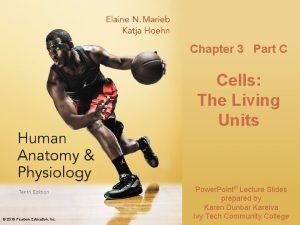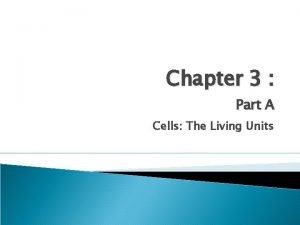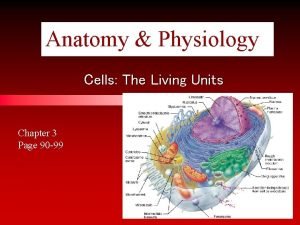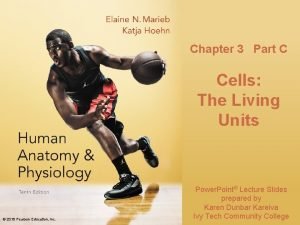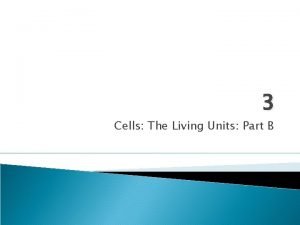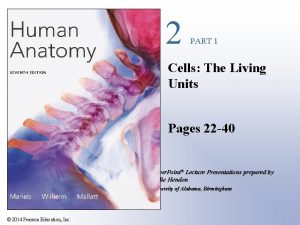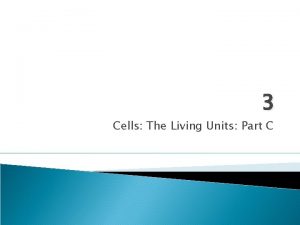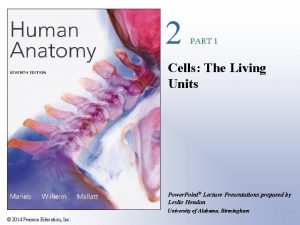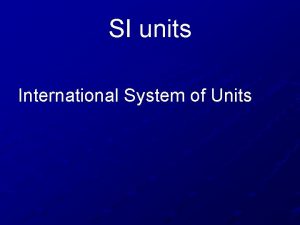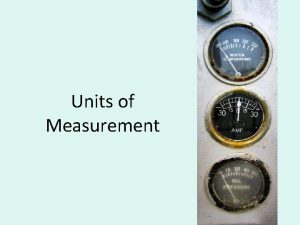Chapter 3 Part C Cells The Living Units

















- Slides: 17

Chapter 3 Part C Cells: The Living Units © Annie Leibovitz/Contact Press Images © 2016 Pearson Education, Inc. Power. Point® Lecture Slides prepared by Karen Dunbar Kareiva Ivy Tech Community College

Figure 3. 15 Mitochondrion. Ribosome Outer mitochondrial membrane Mitochondrial DNA Inner mitochondrial membrane Cristae Matrix Enzymes © 2016 Pearson Education, Inc.

Figure 3. 16 The endoplasmic reticulum. Nucleus Smooth ER Nuclear envelope Rough ER Ribosomes Diagrammatic view of smooth and rough ER © 2016 Pearson Education, Inc. Electron micrograph of smooth and rough ER (25, 000 )

Figure 3. 17 Golgi apparatus. Transport vesicle from rough ER Secretory vesicle Cisterns New vesicles forming Transport vesicle from trans face Trans face— “shipping” side of Golgi apparatus Newly secreted proteins Many vesicles in the process of pinching off from the Golgi apparatus © 2016 Pearson Education, Inc. New vesicles forming Cis face— “receiving” side of Golgi apparatus Transport vesicle at the trans face Electron micrograph of the Golgi apparatus (90, 000 )

Clinical – Homeostatic Imbalance 3. 4 • Lysosomal storage diseases result when one or more lysosomal digestive enzymes are mutated and do not function properly • Tay-Sachs disease is a condition in which the patient lacks a lysosomal enzyme needed to break down glycolipids in brain cells – Glycolipids build up as a result of this defect, interfering with nervous system functioning – Seen predominantly in infants of Central European Jewish descent – Causes seizures, mental retardation, blindness, and death before age 5 © 2016 Pearson Education, Inc.

Figure 3. 20 The endomembrane system. Nucleus Nuclear envelope Smooth ER Rough ER Golgi apparatus Secretory vesicle Plasma membrane © 2016 Pearson Education, Inc. Transport vesicle Lysosome

Figure 3. 21 a Cytoskeletal elements support the cell and help to generate movement. Microfilaments Strands made of spherical protein subunits called actin Actin subunit 7 nm Microfilaments form the blue batlike network in this photo. © 2016 Pearson Education, Inc.

Figure 3. 21 b Cytoskeletal elements support the cell and help to generate movement. Intermediate filaments Tough, insoluble protein fibers constructed like woven ropes composed of tetramer (4) fibrils Tetramer subunits 10 nm Intermediate filaments form the lavender network surrounding the pink nucleus in this photo. © 2016 Pearson Education, Inc.

Figure 3. 21 c Cytoskeletal elements support the cell and help to generate movement. Microtubules Hollow tubes of spherical protein subunits called tubulin Tubulin subunits 25 nm Microtubules appear as gold networks surrounding the cells’ pink nuclei in this photo. © 2016 Pearson Education, Inc.

Figure 3. 22 a Centrioles. Centrosome matrix Centrioles Microtubules © 2016 Pearson Education, Inc.

Figure 3. 22 b Centrioles. © 2016 Pearson Education, Inc.

Figure 3. 24 Ciliary function. Power, or propulsive, stroke 1 2 3 4 Recovery stroke, when cilium is returning to its initial position 5 6 7 Phases of ciliary motion. Layer of mucus Cell surface © 2016 Pearson Education, Inc. Traveling wave created by the activity of many cilia acting together propels mucus across cell surfaces.

Figure 3. 25 Microvilli. Microvillus Actin filaments Terminal web © 2016 Pearson Education, Inc.

Figure 3. 26 a The nucleus. Nuclear pores Nuclear envelope Chromatin (condensed) Nucleolus Cisterns of rough ER © 2016 Pearson Education, Inc. Nucleus

Figure 3. 26 b The nucleus. Surface of nuclear envelope. Fracture line of outer membrane Nuclear pores Nucleus Nuclear pore complexes. Each pore Is ringed by protein particles. © 2016 Pearson Education, Inc. Nuclear lamina. The netlike lamina composed of intermediate filaments formed by lamins lines the inner surface of the nuclear envelope.

Figure 3. 27 b Chromatin and chromosome structure. 3 Tight helical fiber (30 nm diameter) 4 Chromatid (700 nm diameter) 5 Metaphase chromosome (at midpoint of cell division) consists of two sister chromatids © 2016 Pearson Education, Inc.

Figure 3. 26 The nucleus. Surface of nuclear envelope. Fracture line of outer membrane Nuclear pores Nuclear envelope Nucleus Chromatin (condensed) Nucleolus Nuclear pore complexes. Each pore is ringed by protein particles. Cisterns of rough ER Nuclear lamina. The netlike lamina composed of intermediate filaments formed by lamins lines the inner surface of the nuclear envelope. © 2016 Pearson Education, Inc.
 Rough er
Rough er Chapter 3 cells the living units
Chapter 3 cells the living units Mitosis
Mitosis Nondisjunction in meiosis
Nondisjunction in meiosis Paranasal sinuses development
Paranasal sinuses development Transport maximum
Transport maximum Parafollicular cells vs follicular cells
Parafollicular cells vs follicular cells Somatic cells vs gametes
Somatic cells vs gametes Somatic cells vs germ cells
Somatic cells vs germ cells Red blood cells and white blood cells difference
Red blood cells and white blood cells difference What is eukarya
What is eukarya Animal cells and plant cells venn diagram
Animal cells and plant cells venn diagram Prokaryotic cells vs eukaryotic cells
Prokaryotic cells vs eukaryotic cells Cell organelle jeopardy
Cell organelle jeopardy Masses of cells form and steal nutrients from healthy cells
Masses of cells form and steal nutrients from healthy cells Pseudostratified vs simple columnar
Pseudostratified vs simple columnar What animals have prokaryotic cells
What animals have prokaryotic cells Prokaryotic cells vs eukaryotic cells
Prokaryotic cells vs eukaryotic cells
